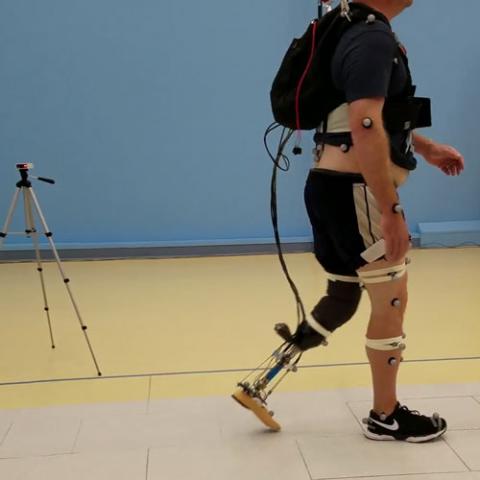Human-Interactive Robotics Lab (HIRoLab)
Walking with the 2-DOF robotic ankle-foot Prosthesis.
Evaluation experiments with our 2-DOF robotic ankle-foot prosthesis were performed in the Motion Analysis Laboratory at Mayo Clinic, Rochester, MN. The experiments included straight walk, step turn, spin turn, and sit-to-stand scenarios.
A novel 2-DOF Instrumented Vibrating Platform for Estimation of the Mechanical Impedance of Ankle during Gait.
The instrumented vibrating platform applies pseudo-random torque perturbations to the ankle during the stance phase of gait. The resulting ankle movements in dorsiflexion-plantarflexion and inversion-eversion are recorded using a camera system. The platform allows for estimation of the mechanical impedance of the ankle during walking in arbitrary directions. Bowden cable transfers the power from the actuation module to the forceplate module, while providing the system with a low profile.
Robotic Falconry! A Prototype Drone-hunting System.
When force-landing a rogue drone does not deter the threat, the solution could be to catch and remove it, then transfer it to a safe zone to be neutralized. It was featured in BBC News Interview, NBC News, BBC News, Fox News, The Washington Post, The Telegraph, The Guardian, Popular Science, Popular Mechanics, CNET, Gizmodo, Engadget, Wired, PhysOrg, Science Daily, KurzweilAI, Gizmag, Motherboard, NH Public Radio, and ASME.
Towards the Agile Gait: A Novel 2-DOF Robotic Ankle-foot Prosthesis.
A robotic ankle-foot capable of dorsiflexion-plantarflexion and inversion-eversion is promising for an agile gait. The actuation system connects to the prosthesis using Bowden cables, allowing for its optimized placement while tailored to the user’s preference. The design versatility would let the user mount and dismount the actuation system based on the planned activities of the day.
Turning on the Circular Treadmill; First Steps!
The platform will be used for developing the control methods for the prototype prosthesis to accommodate different surface profiles and different radiuses of turn. It will be used to explore how a steerable ankle-foot prosthesis may enhance maneuverability for traversing slopes.
Featured in The Engineer, Phys.org, Science Daily, Gizmag, Gigaom, Kurzweil, The O&P Edge, Newswise, ASEE First Bell, and other news outlets.
Steerable Robotic Ankle-foot Prosthesis
The objective of this research is to develop a practical, low-weight, tendon-driven, ankle-foot prosthetic robot capable of steering to enhance agility during turnings and accommodating for the changes in the profile and slope of the ground.
This prototype is aimed to mimic the mechanical impedance of the human ankle in both dorsiflexion-plantarflexion and inversion-eversion DOFs.
Ankle Rotations During Stance Period of Step Turn
This study compares the three-dimentional rotations of the ankle during straight walk and step turn. Infrared camera system (Qualisys Oqus) is used to track the trajectories and angles of the foot and leg at different stages of the gait. The range of motion in inversion-eversion (IE) increased during turning while rotation in lateral-medial (ML) direction decreased and dorsiflexion-plantarflexion (DP) changed the least. The results suggest the addition of an extra controllable degree of freedom in the inversion-eversion direction to prosthetic ankle-foot robots may enhance their maneuverability.
Estimation of Human Ankle Mechanical Impedance
The aim of this study is to estimate the mechanical impedance of human ankle in different periods of gait. The results will be used for the design of the lower extremity assistive robots, including ankle-foot prosthetic robots, that mimic the time-varying mechanical impedance of human ankle during different scenarios of gait, such as steering and traversing a slope that require an ankle joint with controllable degrees of freedom in both sagittal and frontal planes.
Anklebot (Interactive Motion Technologies, Inc.) is the main device used in this study to apply torque perturbations to the human ankle, measure the movement of the foot, and identify the mechanical impedance of the ankle.
This research has been featured in MIT News and other news outlets such as Science Daily and Phys Org.

